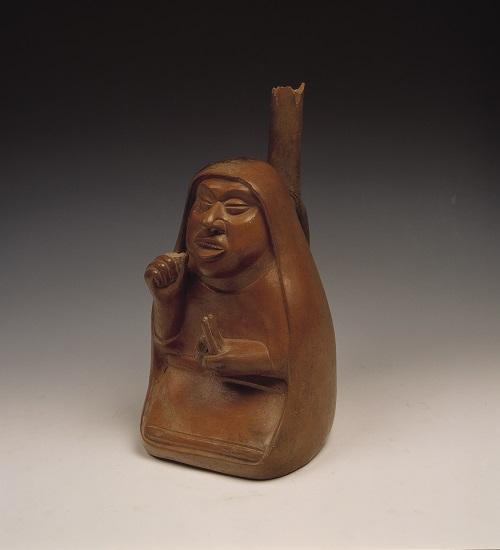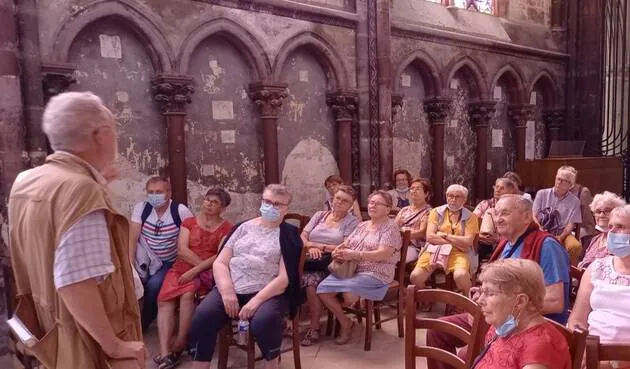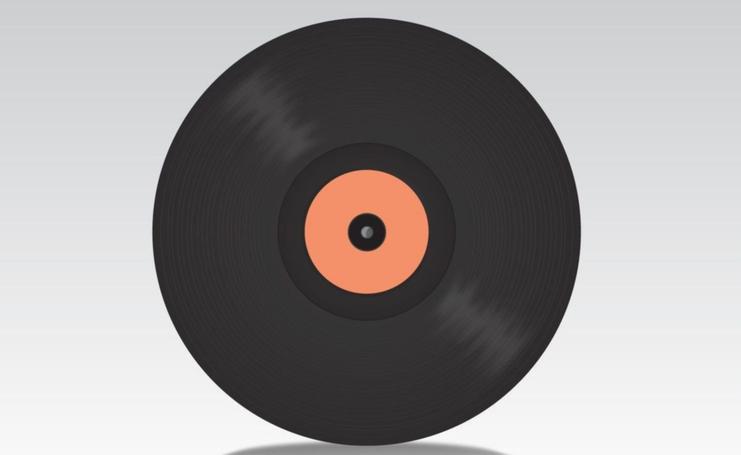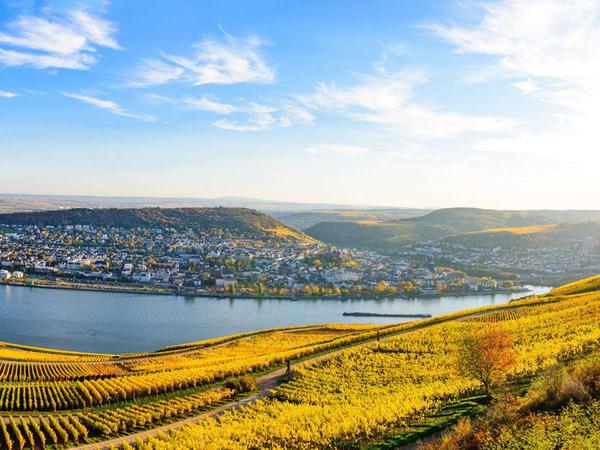Archeology. Shamans of ancient Peru
The lady of Cao was buried in the Huaca Cao Viejo, one of the four sites that make up the El Brujo archaeological complex, located on the coast and north of the current city of Trujillo, in Peru. It is a ceremonial center of the Moche culture in the shape of a truncated pyramid built with millions of adobe bricks. Inside one of the pyramid's chambers, a ceramic pitcher with the face of an owl marked the site of the tomb, where archaeologists unearthed the funerary bundle exactly as it had been deposited more than a thousand years earlier: on a reed mat. and together with a young man sacrificed for the occasion. As in a child's game to unwrap, the twenty-two cotton cloaks that covered the sovereign's body not only hid her precious grave goods but also evidence of her skills as a warrior, priestess, and healer.
The tomb of the priestess of Chornancap, located in the Chotuna-Chornancap archaeological complex, near the present-day city of Lambayeque, in northern Peru, and about five kilometers from the coast, represents another example of the burial of a sovereign ; in this case, of a dignitary of the Lambayeque culture, which chronologically is located a few hundred years after the Mochica, between the 10th and 12th centuries of our era.
These two archaeological discoveries, added to the tombs of the priestesses of San José de Moro, found in the 1990s, and the priestess of Nazca, with her incredible 2.80-meter hair gathered in two braids, put It shows that power in those ancient societies was not an exclusive matter of men, as was thought.
What the Tombs Say
The Lady of Cao died shortly after giving birth in her early twenties. When she removed the last cloak that covered her body, two gold plates were discovered, one that protected her face and the other her heart. Later it was learned that his body was anointed with seawater and made up with cinnabar (mercury sulfide), a red-colored deadly poison that sealed the fate of those who prepared the body.
Thanks to this treatment, the skin was preserved in excellent condition and it was possible to see his impressive tattoos, another sign of his status and the role he played within the Mochica social network. Her arms, hands, and feet were decorated with geometric and animal motifs, such as spiders, snakes, and jaguars, all symbols that linked her to that natural world that at that time was so widely known and feared at the same time.
Among their trousseau were dresses embroidered with life fish (catfish) and ocean waves, reminiscent of the sea from where, according to their beliefs, their supernatural power came. Among the gold, silver, turquoise and spondylus (a warm-water mollusk brought from Ecuador) jewelry with which she was buried, the collection of forty-five finely carved nose rings with different motifs stands out, among them a notable amount of fauna, which show the Moche worldview. The weapons that belonged to her in life were placed under her body and represent the first discovered in the tomb of a woman in the Andean world: twenty-three estolicas and two combat batons.
The priestess of Chornancap died at the age of fifty and was buried with all the emblems of her rank as supreme ruler: crown, scepter, headdress, earmuffs and pectorals, and eight individuals sacrificed in her honor. The two extraordinary cloaks that covered her body were painted with one of the most significant symbols of the Lambayeque culture: the anthropomorphic wave, which established its relationship with the divinity of the sea, that natural element on which this town depended so much. Other objects, such as the cups used in sacrificial rituals and gold earmuffs with the image of the San Pedro cactus, confirm her function as a shaman.
Shamanism

The figure of the shaman or shaman, or spiritual leader, was one of the most prestigious roles in these ancient societies. They were the ones who treasured the knowledge for reading the movements of the stars and studying the tides, which they used to establish agricultural calendars and thus organize community work times. In addition, they predicted the weather and determined the arrival of the rainy season, vital information for an agricultural community.
Thanks to their qualities for connecting with the supernatural world and animals, they fulfilled other functions that can be reconstructed in the archaeological record. No doubt healing was one of his specialties. They healed through the imposition of hands and with plant-based remedies, which included botanical species from the jungle, a region that maintained uninterrupted cultural contacts with the mountains and the coast for thousands of years. In this trade, the deep connection and knowledge of the value that existed in native plants and their characteristics is revealed. Products such as coca, the San Pedro cactus, vilca, corn, quinoa, leguminous resins, clay, sulfur, stones and even animal blood, among an infinity of botanical and mineral species, were used alone or in combination in the art of Andean curanderismo.
The shamans also played a crucial role in assisting in childbirth. Ceramics, that fantastic window that allows us to discover the daily life and symbolic world of these ancient societies, has left as a legacy scenes where shamans, who can be recognized by their tattoos and long tunics, appear helping other women to give birth. , and thanks to these representations we can also know the position that women adopted when giving birth.
Other ceramic pieces show them carrying the San Pedro (or wachuma) cactus, one of the most transcendental plants used by the shamans of the Andes to connect with the supernatural world. This powerful hallucinogen was the favorite link to establish this connection, along with ayahuasca, coca and wilca (or cebil, as it is known in Argentina), plants that played a central role in both healing and rites in the Andean area. .
The scenes of sacrifice and ritual combat, reproduced in many pieces and on different supports (textiles, ceramics, carved stone), especially reveal the importance that shamans had as front-line actors in the different rituals of these cultures.
Ancient Societies
The first complex polities of ancient Peru, dating back 4,500 years, adopted a strong religious bias. Located in the richest fishing grounds in the world and with land and water management that continues to surprise us today, these societies were distinguished by a powerfully religious vision of the landscape, which they understood as the livelihood of their lives. The mountains, the water, the cultivated lands and the animals were not reservoirs of infinite resources: they were divinities with their own names.
They based their economy on intensive agricultural production and fishing and shellfish gathering. The land that gave them food received permanent attention to maintain fertility: it was aerated, fertilized with guano, and protected on terraces so that it did not run down the slopes of the mountains. The water that irrigated the fields was gently transported by canals that in sections blended naturally into the landscape (and are still used in many places!). There was a unique care based on a strong connection and knowledge of the environment that resulted in successful economic production: they turned a desert coast into an orchard, "the warehouse of the Andes", according to an archaeologist.
In addition to ensuring the food of a large population spread over several valleys, this economic management allowed an enormous surplus that was used for monumental construction, obtaining raw materials from distant areas and the development of crafts for rituals and ostentation of power groups.
Natural Forces
However, not everything depended on human labor. Economic activities, especially agriculture, had to assume the risk of an old acquaintance: El Niño, a sudden and devastating climatic phenomenon that had been known since archaic times. Much of the prestige of the elite in power lay in the prediction of this event. El Niño could mean the total destruction of the livelihoods of these peoples, change the social dynamics and erase this complex structure with a stroke of the pen.
When the summer solstice arrived, the shamans had to be informed and attentive. The most relevant data came from the sea and was brought by the fishermen. One sign was the rise in temperature of the cold waters off the Peruvian coast, which triggered a series of changes: usual fish and mollusks disappeared and others, typical of warmer waters, appeared. The mountains, the tides, the wind and even the smallest details of nature also “spoken”; with all the information available, the shamans had to come up with something blank before it was too late.
Andean worldview
The worldview is the way of understanding the world, and the Andean communities did so in a very particular way. Their central concern was to understand the cycles of nature to guarantee their food, and they knew that these were marked by the return of the seasons. According to their beliefs, the cycles were animated by opposite and complementary forces at the same time, a very strong idea represented by the concept of dualism. From the clash of these forces is where the vital energy that gives life and movement to the world arises.
The forces that animate the world, for the Andean worldview, are divided into three planes: the world above (Hanan Pacha), where the gods live and where uncontrollable forces such as wind and storms inhabit; the underworld or world below (Uku Pacha), where the dead live, where life is regenerated and from where food emerges; and the underworld (Kay Pacha), where human beings live and work. Between these worlds there are exchanges: favors are requested, punishments are applied and propitiatory offerings are given.
The justification for the roles and hierarchies lay in the belief that the leaders of these communities were descendants of the gods. These intermediaries who communicate with the different planes of the world, who deliver offerings and pray for good harvests, the fertility of the land and the abundance of the sea, appear before others shining like stars, dressed in all their paraphernalia of precious metals. and wearing insignia that symbolize and transfer the power of supernatural beings to them.
And in this dance of power, and judging by the archaeological discoveries mentioned here, women were able to govern with full power, showing their qualities as shamans, midwives, warriors, healers, weavers. In this profound past, the women who had the possibility of accessing power exercised it in fact, at the top, and thus could be remembered in posterity.
If you like what we do, join the Community
We set ourselves, and we propose to you, the goal of reaching 10,000 collaborators who are connected in the coming months.
That we can reflect reality from below and fight the big media of power, also depends on you.
In order to continue growing, join the Community of La Izquierda Diario.
Join the communityPre-Columbian Latin American History Archaeological Heritage Archeology Peru International History


